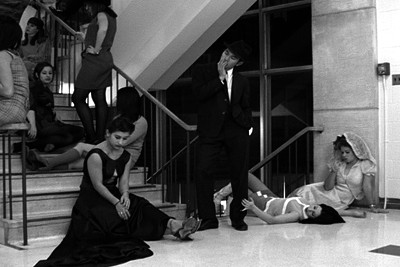'Spoglia' dramatically re-creates Rome
By Daniel Aloi
The classic cinema, culture and ancient and modern architecture of Rome come to the Schwartz Center for the Performing Arts in the original multimedia and dance production "Spoglia," March 6-9.
The show features local and student performers, 19 dancers in black-and-white costumes, a stage set by Christa Seekatz that was inspired by Fascist architecture commissioned by Mussolini for the 1942 World's Fair, and several short films by "Spoglia" director and co-creator Byron Suber, re-creating famous scenes from movies set in Rome including "Roman Holiday," "Accatone" and "La Dolce Vita." The piece also juxtaposes classical music with songs by local musicians Jennie Stearns and Mary Lorson.
"This whole piece has a lot to do with concepts of home and exile, and their music represents home to me," says Suber, a lecturer in theatre, film and dance. "I wanted to present a side of America I really like, and their music is distinctly American."
The work, created in collaboration with choreographer Jumay Chu, was inspired by a summer interdisciplinary course in Rome, "Ancient/Modern Corpo-Realities," taught by Suber. The title, "Spoglia," is derived from the Italian verb "spogliare," meaning "to strip" – referring to the Roman practice of taking elements from antiquity and recycling them into Renaissance architecture.
"They kind of take pieces of classical architecture and jam it into their buildings," Suber says. "I was really interested in examining that. In the field of dance there's a real schism between what is supposed to be classical and what is modern, what is traditional and what is innovative."
The show will be adapted for an international tour with several of the performers. A site-specific performance March 21 in New Orleans' historic St. Roch Market will help draw attention to revitalization efforts there. Other performances are slated for the Chez Bushwick dance center in New York City and then Paris, Rome and Dublin in summer 2008.
Suber used his actors, dancers and musicians in films saluting Federico Fellini, Pier Paolo Pasolini, former A.D. White Professor Michelangelo Antonioni and other filmmakers identified with Rome. The Trevi Fountain scene from Fellini's "La Dolce Vita" was reshot in Cascadilla Gorge with soprano Sharon Costianes in the Anita Ekberg role and violinist Max Bucholtz as Marcello Mastroianni.
"The Italian cinema following World War II, particularly its neorealist films, showed Italy in transition, becoming a modern culture and attempting to shed its traditional past," Suber says. "All the movement in the piece is taken from the films."
Suber also remade the last seven minutes of Antonioni's "L'Ecclise" and a version of Alberto Lattuada's "Gli Italiani si Voltano (The Italians Turn Around)" from the 1953 omnibus film "Amore in Citta (Love in the City)".
"It's shot after shot of beautiful women coming out of doorways," he says. "In the middle you begin to see men appear and look at them. So I remade that in Ithaca with all the students in 1950s costumes, all black and white, and other versions of the film progressing in a direction to have relevance to this piece."
"Spoglia" will be performed March 6-8 at 7:30 p.m. and March 9 at 2 p.m. at the Schwartz Center, with post-show discussions at each performance. Tickets are $10, $8 for students and seniors; available at the box office 12:30-5:30 p.m. weekdays and by calling 607-254-ARTS.
Media Contact
Get Cornell news delivered right to your inbox.
Subscribe